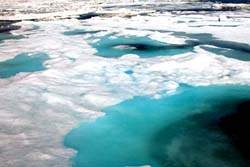|
|
 |
 |
 |
The color of the ice ranged from this beautiful aquamarine blue to
dirty brown.
photo © C. A. Linder, WHOI |
Images and Facts
- Facts
Gallery | Dispatch
Images | Facts | References
The following pages provide a brief introduction to the natural history
of the Arctic. For the purposes of these pages, I have defined this
region as the Arctic Ocean and the land area north of the treeline
(region where trees cannot grow). For a map of this region and to
read about the other definitions of the Arctic region, visit the National
Snow and Ice Data center Arctic Info page. For more detailed information
on Arctic topics, please consult the References
section.
Oceanography 
The Arctic Ocean is unique among the world’s oceans for many
reasons. It is largely ice-covered (much of it year-round, the rest
seasonally), it receives the majority of the fresh-water input from
the world’s rivers (mostly from the Siberian continent), and
it has an abnormally high ratio of shelf to abyssal area.
Comparison of the
Arctic and Antarctic 
The Polar regions cap the opposite ends of the earth. How do they
differ and how are they similar?
Temperature
and Climate 
The Earth's tilt causes huge fluctuations in daylight
at the Poles. Find out more about how this affects temperature and
climate in the Arctic.
Wildlife 
Polar bears, snowy owls, and beluga whales are only
a few of the many fascinating inhabitants of the far north. Read
this page to learn more.
Plant
Life 
This page covers the base of the food chain, from the treeless tundra to the miniature plants of the sea.
Sea Ice 
What is sastrugi? How does pack ice differ from
a growler? This page is all about ice.
Optical Effects 
The Arctic's fogbows, sundogs, and mirages make
it a truly otherworldly place. Read this page for more details about
how these optical effects are formed.
LINK: History of Arctic Exploration 
For centuries explorers and scientists have been
drawn to the Arctic seeking fame and knowledge. This link will take
you to the WHOI Beaufort Gyre Exploration project History pages.
Use your browser's Back button to bring you back to the Arctic Edge
facts section.
|
|




